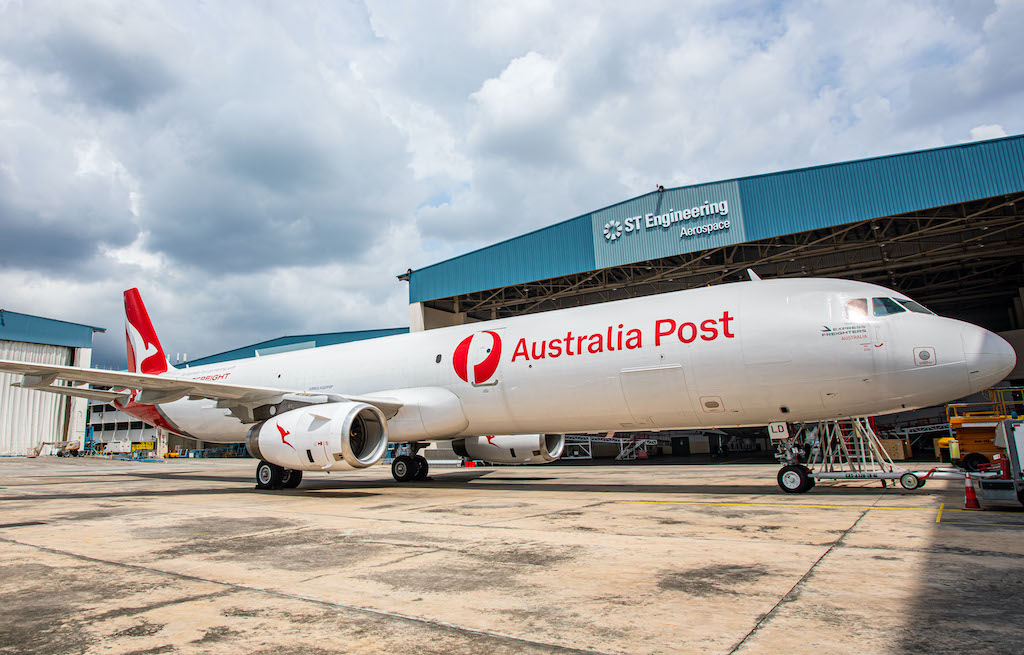Vallair has delivered its pioneering Airbus A321 P2F (passenger to freighter) conversion to launch operator Qantas.
The aircraft, MSN 835, was converted by EFW in at ST Engineering’s facility in Singapore and will be the only aircraft phased into Qantas’ fleet this year.
“The A321 is the future of freighter conversions,” said Vallair CEO Gregoire Lebigot, adding: “Not only is this freighter variant better for the environment due to its 20% reduction in fuel burn, but it offers enhanced performance across range, payload and volume with a unique capacity for fourteen container positions in the upper deck and ten more on the containerised lower cargo deck.
“Thanks to its fly by wire technology, the A321 is more advanced and the aircraft is still in production.”
Lebigot affirmed that Vallair understood the potential of the A321P2F at the outset: “We took the decision early on to invest in the prototype conversion. Converting a passenger plane to cargo is an extremely complex undertaking which needs to be managed by highly experienced people. This applies not only to the physical conversion process, but also in terms of engineering and project management.
“The development and launch of the A321 freighter is testament to all the teams that have worked tirelessly on this unique project. It has taken several years of hard work to reach this milestone and Vallair is delighted to be in the position to deliver the very first conversion of this type to Qantas Freight who will operate the aircraft on behalf of Australia Post.”

With a number of future aircraft deliveries already scheduled, Vallair’s narrow body cargo conversion programme is experiencing firm interest from well-established and forward-looking freight operators worldwide.
A lease agreement with SmartLynx Malta for two newly converted A321-200 freighters was recently concluded and last week Vallair announced a ground-breaking deal with GlobalX, the new Miami-based airline, who have signed an LoI to lease ten A321F conversions which will be delivered and operational by Spring 2023.
It is anticipated that cargo specialists will require about 1,500 narrowbody converted aircraft over the next ten years. Of this total, 1,000 will replace the existing older fleet and 500 will be needed to support increased demand fuelled particularly by booming e-commerce. For the same period, Vallair believes the industry could see around 400 A321Fs take to the skies.
ST Engineering, Airbus and their joint venture, Elbe Flugzeugwerke (EFW) achieved a key milestone in their joint A321 passenger-to-freighter (P2F) conversion programme in September this year with the re-delivery of the ‘head of version’ to launch customer, Vallair.
Both milestones marked the completion and birth of the world’s first A321 converted freighter. EFW had received the original Supplemental Type Certificate (STC) for the A321P2F from the European Union Aviation Safety Agency (EASA) in February this year, and the Validation STC from the U.S. Federal Aviation Administration in July. Operator specific enhancements were subsequently incorporated into the freighter and certified prior to its re-delivery.
Jeffrey Lam, President of ST Engineering’s Aerospace sector, said, “Through our collaboration with the aircraft OEM, Airbus, we have been able to develop a high performance product and obtain the original STC from EASA within a week from completing the flight tests, all within schedule and while maintaining our high standards in safety and quality.
“The completion of our first A321P2F is timely, as the programme can help airlines breathe new life into underutilised aircraft, which would otherwise suffer a harder landing in their residual value. With the A321P2F platform being the best-in-class for its size category – having 55 percent more volumetric capacity than its nearest competitor – we are confident that the programme will be a great success in the freighter market.”
Andreas Hermann, Vice President of Asset Management at Airbus and member of the EFW shareholder committee said: “We are very pleased to see the A321P2F programme entering service. The Airbus A321 is the platform which, by design, will offer the best economics, cargo capacity and performance in the single-aisle freighter segment going forward.
“For any asset owner, this will provide an excellent opportunity to leverage future growth and replacement waves, underpinning the already great value proposition of the A321 today.”
Said Andreas Sperl, Chief Executive Officer of EFW: “We are excited to welcome this newest member A321P2F, which is the result of a successful collaboration with ST Engineering and Airbus, into our suite of Airbus freighter conversions,” . “Given the outstanding performance of this freighter, we are confident that the A321P2F will be a game changer in the freighter market.”
The A321P2F is the first in its size category to offer containerised loading in both the main (up to 14 full container positions) and lower deck (up to 10 container positions). With a generous payload-range capability that can carry above 28 metric tons (roughly 60,000 lbs) over 2,300 nautical miles, the A321P2F is the ideal narrowbody freighter aircraft for express domestic and regional operations.
The conversion features a large main cargo door which is hydraulically actuated and electrically locked, a Class E cargo compartment with full rigid 9g barrier for optimal protection between crew and cargo, and a redefined flight deck that includes supernumerary seats and a new lavatory.
The collaboration between ST Engineering, Airbus and EFW is the only OEM solution for A321P2F in the market. EFW, which is leading the overall programme as well as marketing and sales efforts, has been seeing a keen interest in the solution, which is expected to further grow with the first A321P2F unit entering the market.
To meet rising demand for dedicated freighter aircraft, ST Engineering and EFW are planning to set up additional modification sites in China, Germany and the U.S. by 2023 to ramp up global conversion capacity to about 25 slots per year.

